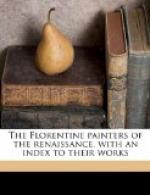IX.
[Page heading: VERROCCHIO AND LANDSCAPE]
In all that concerns movement, Verrocchio was a learner from Pollaiuolo, rather than an initiator, and he probably never attained his master’s proficiency. We have unfortunately but few terms for comparison, as the only paintings which can be with certainty ascribed to Verrocchio are not pictures of action. A drawing however like that of his angel, in the British Museum, which attempts as much movement as the Hercules by Pollaiuolo, in the same collection, is of obviously inferior quality. Yet in sculpture, along with works which are valuable as harbingers of Leonardo rather than for any intrinsic perfection, he created two such masterpieces of movement as the “Child with the Dolphin” in the courtyard of the Palazzo Vecchio, and the Colleoni monument at Venice—the latter sinning, if at all, by an over-exuberance of movement, by a step and swing too suggestive of drums and trumpets. But in landscape Verrocchio was a decided innovator. To understand what new elements he introduced, we must at this point carry out our determination to enquire into the source of our pleasure in landscape painting; or rather—to avoid a subject of vast extent for which this is not the place—of landscape painting as practised by the Florentines.
[Page heading: LANDSCAPE PAINTING]
Before Verrocchio, his precursors, first Alessio Baldovinetti and then Pollaiuolo, had attempted to treat landscape as naturalistically as painting would permit. Their ideal was to note it down with absolute correctness from a given point of view; their subject almost invariably the Valdarno; their achievement, a bird’s-eye view of this Tuscan paradise. Nor can it be denied that this gives pleasure, but the pleasure is only such as is conveyed by tactile values. Instead of having the difficulty we should have in nature to distinguish clearly points near the horizon’s edge, we here see them perfectly and without an effort, and in consequence feel great confirmation of capacity for life. Now if landscape were, as most people vaguely believe, a pleasure coming through the eyes alone, then the Pollaiuolesque treatment could be equalled by none that has followed, and surpassed only by Rogier van der Weyden, or by the quaint German “Master of the Lyversberg Passion,” who makes us see objects miles away with as great a precision and with as much intensity of local colour as if we were standing off from them a few feet. Were landscape really this, then nothing more inartistic than gradation of tint, atmosphere, and plein air, all of which help to make distant objects less clear, and therefore tend in no way to heighten our sense of capacity. But as a matter of fact the pleasure we take in actual landscape is only to a limited extent an affair of the eye, and to a great extent one of unusually intense well-being. The painter’s problem, therefore, is not merely to render the tactile




